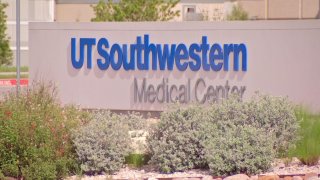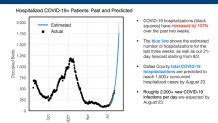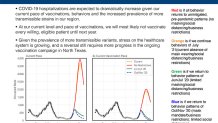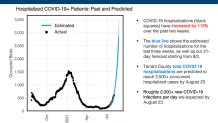
UT Southwestern's latest COVID-19 forecast predicts a spike in virus-related hospitalizations that could surge past peaks seen in January by the end of this month if behaviors aren't changed.
UTSW said hospital volumes have risen 99% in the past two weeks and 327% over the past month and that the trend will only increase if more people don't get vaccinated and if more mitigation efforts aren't undertaken.
"The total number of people hospitalized for COVID-19 in North Texas is expected to substantially increase over the next several weeks," UTSW said in their report. "Critically, the current pace of hospitalization growth could put Dallas and Tarrant counties above January surge levels before September, placing increased stress on the collective capacity of regional health systems."
According to the study, should behavior in Dallas and Tarrant counties continue in the current unmitigated, pre-pandemic patterns, with no masking and no social distancing, the number of occupied hospital beds in Dallas County is predicted to reach 1,500 by Aug. 23 and could reach 4,000 by October.
Get DFW local news, weather forecasts and entertainment stories to your inbox. Sign up for NBC DFW newsletters.


In Tarrant County, under the same set of circumstances, the study predicts 2,500 concurrent hospitalizations by Aug. 23.

The model also predicts roughly 2,000 new COVID-19 infections per day in each county by Aug. 23 if no mitigation is put into place. The predicted increases in new cases, UTSW said, are due to the high levels of transmission of the delta variant and the large numbers of people who are not yet vaccinated against the virus.
UTSW's model highlights that curbing the spread of the virus is reliant upon increasing the number of vaccinations and modifying current behavior patterns to mirror those of October-November 2020 when there were mask mandates, limited social distancing and some restrictions placed on businesses.
Should those mitigation efforts be restored, the model predicts the peak of this fourth wave would begin to drop much more quickly.
UTSW said it is still possible to avoid the worst-case scenarios if vaccination volumes return to prior levels. They added that people under 65 make up the largest segment of hospitalizations and that because they are unvaccinated they remain particularly susceptible to infection.
"Increased personal adherence to indoor masking, physical distancing, and other interventions recommended by health experts will be necessary to protect the health of Texans who are currently unvaccinated or who may be immunocompromised," UTSW said.
The hospital recommends visiting the CDC website for guidance on which kinds of activities are safe once fully vaccinated, as well as which levels of prevention are recommended.
UTSW created the report based on data received through Aug. 2 and 3 and added that it is important to remember that people arriving at the hospital today were likely infected around 2 weeks ago -- meaning any change in behavior will take some time to show up in the data.
"Increasing compliance with prevention measures and increasing vaccination rates will help us control transmission in North Texas," UTSW said.

